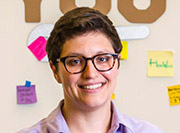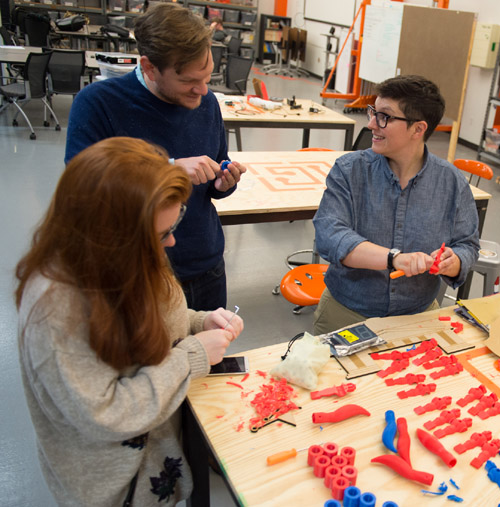Katie Krummeck reshapes the Deason Innovation Gym as a space for more than just engineering students
Katie Krummeck is making the Deason Innovation Gym a welcoming place for engineers and non-engineers alike.

By Emily Hooper
SMU News
DALLAS (SMU) – For the non-engineer, what goes on inside the Darwin Deason Innovation Gym (DIG) may seem just a little too intimidating.
 Katie Krummeck (right) works with colleague Gray Garmon and student Justine Gallagher on a foosball table the team built from scratch at the Deason Innovation Gym.. |
But Katie Krummeck, the new director of the DIG at the Lyle School of Engineering, is making it one of her priorities to break down those perceived barriers. And in the process, she is not only enhancing the learning experience for Lyle students, she is inspiring and encouraging the entire SMU community to become “makers.”
The primary mission of the DIG is to enhance engineering education through hands-on learning, which is the heart and soul of the “makerspace” movement. Best described as a facility combining a design studio, machine shop, and a garage, the DIG provides undergraduate engineering students, as well as those in other SMU disciplines, the tools and space to work together. Their immersion design projects and competitions accelerate leadership development and create a framework for innovation.
As the DIG’s director, Krummeck believes that all students can become “makers,” taking on the mindset that almost any problem is solvable with a little perseverance, focus, tinkering and help from fellow makers. She believes that creative confidence is the key to success in the 21st century and that “making” is an excellent way to build those mindsets in students.
“Making, like any true learning, activates an insatiable curiosity and a deeply intrinsic motivation to see a project through,” says Krummeck. “This self-motivated desire to learn helps students overcome challenges, solve problems and persevere in the face of ambiguity and complexity. Making something also provides students with tangible evidence that they can create change in the world.”
And while Krummeck is running a centerpiece program in the Lyle School, she is not an engineer. “Katie is a fantastic example of a confident, thoughtful maker who has a non-technical background,” says Kate Canales, director of design and innovation programs in the Lyle School of Engineering. “I think that perspective and positioning is extremely valuable for both engineering students and non-engineering students."
To help students build creative confidence and develop a maker identity, Krummeck and Canales teach something called “design thinking.” It is a process for innovating and thinking creatively and for wading into complex topics to find compelling solutions, bringing together what people want and need with what is technologically feasible.
“You can’t give students a blank piece of paper and expect them to create something innovative and wonderful. You also can’t implement a strict structure that stifles creativity,” says Krummeck. “Design thinking creates a scaffold for students to move through complex issues. It encourages students to view feedback as a gift, challenge their own assumptions and approach every problem with empathy to create meaningful solutions.”
Since joining SMU from Stanford University, Krummeck has developed design-thinking programming to engage the greater SMU community. By implementing community challenges that are open to all SMU students, Krummeck is quickly transforming the DIG into a space where all students feel welcome. To ensure that students’ needs are being met, she has been conducting design research to try to better understand the interests and skills of SMU students.
Krummeck thinks most students fit three common profiles: First, there are the students that already possess the skills and interests to use the DIG. Second, there are the students who are interested in the DIG, but lack a strong purpose for what they want to make. Third, there are the students who have no interest in or knowledge of the DIG. Krummeck hopes community challenges will further engage those who already possess the skills and interests, give purpose to those who have interest, and draw in those who may have no knowledge of the DIG.
“I want all students to know that they are welcome,” says Krummeck. “I hope to lower the intimidation factor to help students gain traction so that they can make something of their own and build creative confidence.”
Krummeck has hosted a community challenges as well as several workshops, including a custom t-shirt workshop in her first semester on campus. Each challenge has been designed to engage students of all skill levels. During the challenges, students engage in hands-on learning and are taught to use the technology in the DIG to make something real.
Community challenges are not only engaging the greater SMU community, she says, they also are enhancing the learning experience for Lyle students.
“Introducing diverse backgrounds into the Innovation Gym creates diverse mental models and pushes engineering students to think in different ways to create stronger solutions,” says Krummeck. “Engaging the greater SMU community also provides Lyle students with an unrivaled opportunity to lead and improve their communication skills.”
Krummeck also is continuing efforts to broaden the community outreach beyond SMU’s campus. In January 2016, 10-12 SMU students will be selected to participate in a seven-day Immersive Design Challenge (IDC) with Parish Episcopal School. Their shared design challenge will focus around the question, “How might we bring engaging, hands-on learning to children who have been admitted to the hospital for long-term care?”
The team of SMU students will design plans, recommendations for tools and materials, a proposed budget for the program, a marketing strategy, four curriculum modules and a plan for prototyping the program in a local hospital. This design challenge provides a unique opportunity for students to engage in the community, Krummeck says. Students will immerse themselves in a real world problem to design meaningful, practical learning for children confined to hospital rooms.
About Katie Krummeck
Krummeck holds a B.A. in American Studies with a minor in Education from Whitman College in Walla Walla, Washington. She began her career as a secondary teacher and co-founder of a small, experimental independent school. She worked for an education non-profit start-up and, before coming to SMU, worked at the respected Hasso Plattner Institute for Design at Stanford University. Krummeck describes herself as an educator by training, a maker by trial and error, a learning experience designer and a steadfast believer in the power of empathy to bring compassionate solutions to the messiest of human problems.
“Throughout my career, I have always been asking questions about how people learn and how that learning empowers them to be self-actualized. From starting a school, to working at a real-world learning based education non-profit start-up, I consistently found that the people asking similar questions as me and then experimenting to answer those questions, were working in new ways in the education space,” says Krummeck. So, when I discovered the process of design thinking I was inspired. Here was a process to drive forward the kind of thinking and experimentation I had been doing instinctually.”
Krummeck was first exposed to design thinking by chance. A friend who was interested in testing out an activity meant to introduce design thinking without a facilitator asked for her help. Krummeck realized that design thinking provided a framework for learning and doing that truly empowers people to be agents of change -- exactly what she had been working toward in her own curriculum and program design.
“I was so lucky to be given the opportunity to pivot my career and work on using design thinking and making in the K-12 educational space. That pivot has really changed the trajectory of my life, but it also aligns with the work I had been doing from the start,” says Krummeck. “I am so excited to be able to stretch myself in new ways at SMU in the DIG, while also bringing my insights and background in design thinking and maker education to such a unique and innovative space.”
About the DIG Immersion Design Challenge
Formerly known as the Immersion Design Experience (IDE), the Immersion Design Challenge (IDC) at SMU takes small teams of students and presents them with a real world problem submitted by a business or organization that must be solved in less than 10 days. Teams are required to design, fabricate, build, and test a prototype that solves their assigned problem, and then present their solution to a panel of faculty and industry representatives. IDC students work on average 18 hours a day with no breaks, and it’s not uncommon to see students napping in sleeping bags during the competition period. Because this high intensity workload interferes with traditional class time, IDCs are run during the breaks in the academic calendar – typically at the end and beginning of summer, winter break and spring break. Students give up nearly two weeks of vacation to work on challenging projects for no money, and no credit.
The January 2016 IDC will be the tenth hosted at SMU. In the past, students engaged in Immersion Design Experiences have partnered with 7-Eleven, the US Marine Corps and Lockheed Martin.
To learn more about the Immersion Design Experience visit: http://www.smu.edu/Lyle/Institutes/CaruthInstitute/InnovationPrograms/IDEs
About the Deason Innovation Gym
The Deason Innovation Gym is built to change engineering education through hands-on learning. Best described as a facility combining a design studio, machine shop, and a garage, the Deason Innovation Gym provides undergraduate engineering students, as well as those in other SMU discipline, the tools and space to work together on immersion design projects and competitions to accelerate leadership development and the framework for innovation.
To learn more about the Deason Innovation Gym visit: www.theDIG.org
###